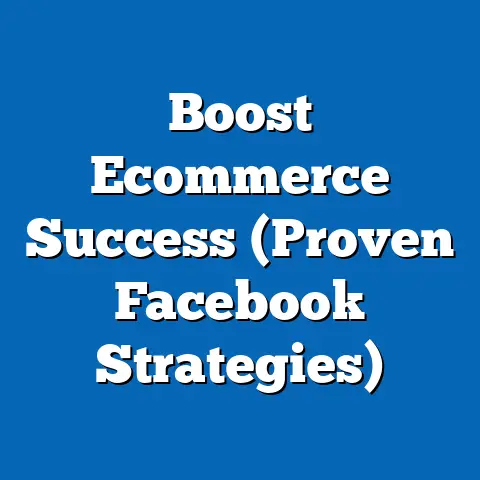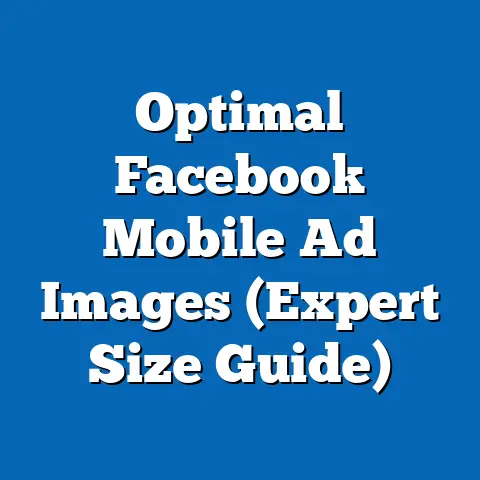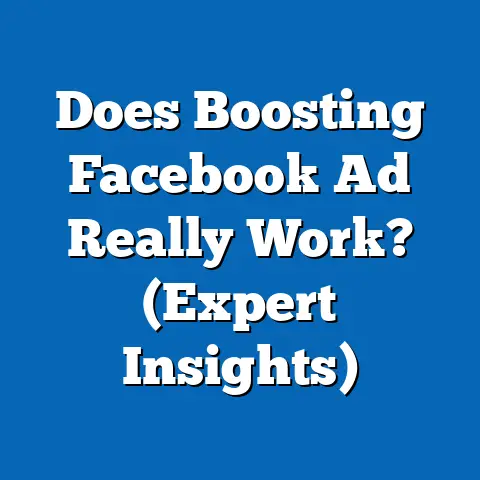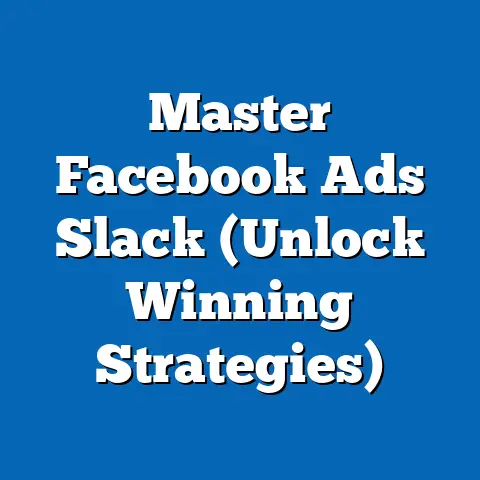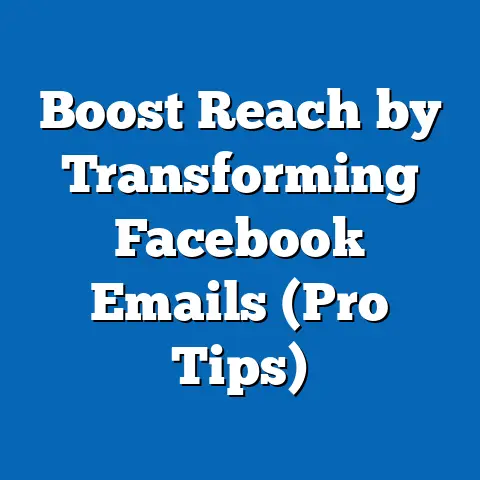Escape Facebook Ads (Proven Strategies for Instant Relief)
I’ve seen firsthand how frustrating Facebook advertising can be, especially for businesses operating in competitive markets. The constant algorithm changes, rising ad costs, and the ever-present challenge of breaking through the noise can leave marketers feeling overwhelmed and, frankly, a little defeated. I remember working with a local bakery a few years back; they were pouring money into Facebook Ads, but their sales barely budged. They were ready to give up, convinced that Facebook Ads just didn’t work for them. That’s when I realized the urgent need for effective, actionable strategies to help businesses regain control and see real results. That’s what I want to share with you today.
Section 1: Understanding the Facebook Ads Landscape
The Facebook Ads landscape in North America is a dynamic and complex ecosystem. With over 240 million active users in the US alone (Statista, 2023), Facebook presents a massive opportunity for businesses to reach a broad audience. However, this vast potential comes with its own set of challenges.
The North American market is incredibly competitive. Numerous businesses, from multinational corporations to small local shops, are vying for the same ad space. This high demand drives up ad costs, making it increasingly difficult for smaller businesses to compete with larger budgets.
Another key characteristic of the North American Facebook Ads landscape is the sophistication of its users. North American consumers are generally tech-savvy and have developed a keen sense for distinguishing genuine content from blatant advertising. This means that generic, poorly targeted ads are likely to be ignored, leading to wasted ad spend and low conversion rates.
Furthermore, declining organic reach continues to be a significant pain point for businesses. Facebook’s algorithm prioritizes content from friends and family, making it harder for businesses to get their organic posts seen by their followers. This forces businesses to rely more heavily on paid advertising to reach their target audience.
Consider this: A recent study by HubSpot found that only 5.2% of a Facebook Page’s followers see its organic posts on average. This stark reality underscores the need for a robust Facebook Ads strategy to effectively reach potential customers.
Many businesses in North America are currently using Facebook Ads for a variety of purposes, including:
- Brand Awareness: Reaching a large audience to increase brand recognition.
- Lead Generation: Collecting contact information from potential customers.
- Website Traffic: Driving traffic to their website to increase sales or engagement.
- E-commerce Sales: Promoting products and services directly on Facebook.
However, the typical outcomes often vary. Some businesses experience significant success, generating high ROI and achieving their marketing goals. Others struggle to see a return on their investment, leading to frustration and disillusionment.
Key Takeaway: The Facebook Ads landscape in North America is competitive, sophisticated, and constantly evolving. Understanding these dynamics is crucial for developing an effective advertising strategy that can cut through the noise and achieve desired results.
Section 2: Identifying the Root Causes of Facebook Ads Inefficacy
Why are some businesses thriving on Facebook Ads while others are floundering? In my experience, the answer often lies in identifying and addressing the root causes of ineffectiveness. Here are some of the most common problems I’ve encountered:
- Poor Targeting: This is perhaps the most pervasive issue. Many businesses fail to define their target audience accurately, resulting in ads being shown to irrelevant users who are unlikely to be interested in their products or services. For example, a local sporting goods store might target all Facebook users in their city, rather than focusing on users who have expressed an interest in sports or outdoor activities.
- Ineffective Ad Copy: Even with precise targeting, lackluster ad copy can kill your campaign. Generic, uninspired ads that fail to capture attention or communicate value are likely to be ignored. Think of those ads that simply list product features without highlighting the benefits to the customer.
- Inadequate Budget Allocation: Setting the right budget is crucial for success. Underfunding your campaigns can limit your reach and prevent you from gathering enough data to optimize your ads. Overspending without a clear strategy can lead to wasted ad spend and a poor ROI.
- Lack of A/B Testing: Without continuous testing, you’re essentially flying blind. Many businesses fail to experiment with different ad creatives, targeting options, and bidding strategies, preventing them from identifying what works best for their audience.
- Ignoring Mobile Optimization: With the majority of Facebook users accessing the platform on mobile devices, neglecting mobile optimization is a critical mistake. Ads that are not optimized for mobile viewing can be difficult to read and interact with, leading to poor engagement.
- Not Tracking Conversions: If you’re not tracking conversions, you have no way of knowing whether your ads are actually generating leads or sales. Without this data, it’s impossible to measure your ROI and make informed decisions about your campaigns.
Let me share a real-life example. I worked with a local clothing boutique that was struggling with their Facebook Ads. They were targeting a broad demographic of women in their city and running ads featuring generic product photos. Their click-through rate was abysmal, and they weren’t seeing any sales.
After analyzing their campaign, I identified several key issues. First, their targeting was too broad. They were targeting women of all ages and interests, rather than focusing on their ideal customer: young, fashion-conscious women who were interested in trendy clothing. Second, their ad copy was uninspired and failed to highlight the unique value proposition of their boutique. Third, they weren’t tracking conversions, so they had no way of knowing which ads were actually driving sales.
By addressing these issues – refining their targeting, crafting compelling ad copy, and implementing conversion tracking – we were able to significantly improve their ad performance and generate a positive ROI.
Key Takeaway: Identifying and addressing the root causes of Facebook Ads ineffectiveness is crucial for turning around struggling campaigns. By focusing on improving targeting, ad copy, budget allocation, and tracking, you can significantly increase your chances of success.
Section 3: Proven Strategies for Instant Relief
Now that we’ve identified the common challenges and their root causes, let’s dive into the strategies that can provide you with “Instant Relief” and transform your Facebook Ads performance.
Subsection 3.1: Creative Ad Formats
In a world saturated with online content, capturing attention is paramount. I’ve found that leveraging innovative ad formats is a powerful way to cut through the noise and engage your target audience.
- Video Ads: Video is king. Videos are far more engaging than static images or text-based ads. Short, attention-grabbing videos that tell a story or showcase your product in action can significantly boost your click-through rate and conversion rates. According to a report by Wyzowl, 86% of businesses use video as a marketing tool, and 93% of marketers say video has helped them increase brand awareness.
- Carousel Ads: Carousel ads allow you to showcase multiple images or videos in a single ad unit. This format is perfect for highlighting different products, features, or benefits. I’ve seen carousel ads work exceptionally well for e-commerce businesses looking to showcase their product catalog.
- Collection Ads: Collection ads are designed specifically for e-commerce businesses. They combine a video or image with a selection of related products, allowing users to browse and purchase directly from the ad. This format provides a seamless shopping experience and can significantly increase sales.
- Instant Experience Ads (formerly Canvas Ads): These full-screen, mobile-optimized ads provide an immersive and interactive experience for users. They can include videos, images, carousels, and even interactive elements like forms and quizzes. Instant Experience ads are ideal for telling a brand story or showcasing a product in detail.
Tips for Creating Compelling Visuals and Copy:
- Know Your Audience: Tailor your visuals and copy to resonate with your specific target audience. Use language and imagery that appeals to their interests and values.
- Focus on Benefits: Highlight the benefits of your product or service, rather than just listing its features. Explain how it can solve their problems or improve their lives.
- Use High-Quality Images and Videos: Invest in professional-quality visuals that are visually appealing and engaging. Avoid using blurry or pixelated images.
- Keep it Short and Sweet: Attention spans are short. Get to the point quickly and avoid using overly long or complex copy.
- Include a Clear Call to Action: Tell users exactly what you want them to do, whether it’s to visit your website, make a purchase, or sign up for a newsletter.
Key Takeaway: Experimenting with different ad formats and crafting compelling visuals and copy are essential for capturing attention and driving engagement on Facebook Ads.
Subsection 3.2: Targeting the Right Audience
I can’t stress enough how critical precise targeting is for Facebook Ads success. Showing your ads to the wrong people is like shouting into the void – you’re wasting your time and money.
- Custom Audiences: Custom audiences allow you to target users who have already interacted with your business, such as website visitors, email subscribers, or customers. This is a highly effective way to re-engage existing customers and drive repeat sales.
- Lookalike Audiences: Lookalike audiences allow you to target users who are similar to your existing customers. This is a powerful way to expand your reach and find new customers who are likely to be interested in your products or services.
- Interest-Based Targeting: Interest-based targeting allows you to target users based on their interests, hobbies, and activities. This is a good option for reaching a broader audience who may not be familiar with your business.
- Behavioral Targeting: Behavioral targeting allows you to target users based on their online behavior, such as their purchase history, device usage, and travel habits. This can be a highly effective way to reach users who are actively in the market for your products or services.
- Demographic Targeting: Demographic targeting allows you to target users based on their age, gender, location, education, and other demographic factors. This is a good option for targeting a specific segment of the population.
Leveraging Local Trends and Behaviors:
- Stay Updated on Local Events: Target users who are interested in attending local events, such as festivals, concerts, or sporting events.
- Monitor Local News and Trends: Use local news and trends to inform your ad copy and targeting. For example, if there’s a heatwave in your city, you could run ads promoting your air conditioning services.
- Partner with Local Influencers: Collaborate with local influencers to reach their followers and promote your products or services.
- Use Location-Based Targeting: Target users who are located within a specific radius of your business.
Key Takeaway: Refining your targeting is crucial for reaching the right audience and maximizing your ROI on Facebook Ads. By leveraging custom audiences, lookalike audiences, and interest-based targeting, you can significantly improve your ad performance.
Subsection 3.3: Optimization Techniques
I’ve learned that Facebook Ads is not a “set it and forget it” platform. Continuous optimization is essential for maximizing your results.
- A/B Testing: A/B testing involves creating two or more versions of an ad and testing them against each other to see which performs best. This is a crucial step in optimizing your ad copy, visuals, and targeting.
- Split Testing: Similar to A/B testing, split testing allows you to test different elements of your campaign, such as your bidding strategy or placement.
- Landing Page Optimization: Make sure your landing page is optimized for conversions. This means having a clear call to action, a compelling headline, and a user-friendly design.
- Ad Scheduling: Schedule your ads to run during the times when your target audience is most active on Facebook.
- Budget Optimization: Continuously monitor your ad spend and adjust your budget based on performance.
- Placement Optimization: Test different ad placements to see which performs best for your target audience.
Key Performance Indicators (KPIs) to Monitor:
- Click-Through Rate (CTR): The percentage of users who click on your ad.
- Cost Per Click (CPC): The amount you pay for each click on your ad.
- Conversion Rate: The percentage of users who take the desired action, such as making a purchase or signing up for a newsletter.
- Cost Per Conversion (CPC): The amount you pay for each conversion.
- Return on Ad Spend (ROAS): The amount of revenue you generate for every dollar you spend on advertising.
Key Takeaway: Continuous optimization is essential for maximizing your results on Facebook Ads. By implementing A/B testing, split testing, and monitoring key performance indicators, you can continuously improve your ad performance and achieve your marketing goals.
Subsection 3.4: Budgeting and Bidding Strategies
I’ve seen many businesses struggle with setting the right budget and choosing the right bidding strategy. It’s a delicate balance, but mastering this aspect of Facebook Ads is crucial for success.
- Setting an Appropriate Budget: Your budget should be based on your marketing goals, your target audience size, and your industry. A good starting point is to allocate 10-15% of your overall marketing budget to Facebook Ads.
- Choosing the Right Bidding Strategy: Facebook offers a variety of bidding strategies, including:
- Automatic Bidding: Facebook automatically sets your bids based on your budget and target audience.
- Manual Bidding: You manually set your bids for each ad.
- Cost Cap Bidding: You set a maximum cost per result.
- Target Cost Bidding: You set a target cost per result.
- Monitoring Ad Spend: Continuously monitor your ad spend and adjust your bids based on performance. If you’re not seeing the results you want, you may need to increase your budget or adjust your bidding strategy.
- Automatic Bidding: Facebook automatically sets your bids based on your budget and target audience.
- Manual Bidding: You manually set your bids for each ad.
- Cost Cap Bidding: You set a maximum cost per result.
- Target Cost Bidding: You set a target cost per result.
Tips for Effective Budget Management:
- Start Small: Begin with a small budget and gradually increase it as you see results.
- Set a Daily Budget: Set a daily budget to prevent overspending.
- Monitor Your Ad Spend Regularly: Check your ad spend daily to ensure you’re on track.
- Adjust Your Bids Based on Performance: If your ads are performing well, you can increase your bids to reach a larger audience. If they’re not performing well, you can decrease your bids to save money.
Key Takeaway: Setting the right budget and choosing the right bidding strategy are crucial for maximizing your ROI on Facebook Ads. By carefully monitoring your ad spend and adjusting your bids based on performance, you can ensure that you’re getting the most bang for your buck.
Subsection 3.5: Leveraging Facebook Analytics and Insights
I always tell my clients, “Data is your best friend in the world of digital marketing.” Facebook Analytics and Insights provide a wealth of information that you can use to improve your ad performance.
- Understanding Your Audience: Facebook Analytics provides detailed information about your audience, including their demographics, interests, and behaviors.
- Tracking Ad Performance: Facebook Insights allows you to track the performance of your ads, including your click-through rate, conversion rate, and cost per conversion.
- Identifying Trends: Facebook Analytics can help you identify trends in your audience’s behavior, such as the times of day when they’re most active on Facebook.
- Optimizing Your Campaigns: Use the data from Facebook Analytics and Insights to optimize your campaigns and improve your results.
Tips for Interpreting Data:
- Focus on the Metrics That Matter: Don’t get bogged down in vanity metrics like likes and shares. Focus on the metrics that directly impact your bottom line, such as conversions and ROAS.
- Look for Patterns: Look for patterns in your data to identify trends and opportunities.
- Test Your Hypotheses: Use the data to test your hypotheses and see what works best for your audience.
- Don’t Be Afraid to Experiment: Experiment with different ad creatives, targeting options, and bidding strategies to see what generates the best results.
Key Takeaway: Facebook Analytics and Insights are powerful tools that you can use to gain insights into your audience and improve your ad performance. By carefully analyzing the data and using it to optimize your campaigns, you can significantly increase your ROI on Facebook Ads.
Subsection 3.6: Building a Strong Brand Presence
I believe that Facebook Ads are most effective when they’re part of a larger brand-building strategy.
- Brand Consistency: Ensure that your ads are consistent with your brand’s overall messaging and visual identity.
- Engaging Content: Create engaging content that resonates with your target audience.
- Community Building: Foster a sense of community around your brand by encouraging interaction and responding to comments and questions.
- Customer Service: Provide excellent customer service on Facebook to build trust and loyalty.
Strategies for Fostering Community Engagement:
- Run Contests and Giveaways: Contests and giveaways are a great way to generate excitement and engagement.
- Ask Questions: Ask your followers questions to encourage them to share their thoughts and opinions.
- Run Polls: Run polls to gather feedback from your followers and learn more about their preferences.
- Share User-Generated Content: Share content created by your followers to show that you value their contributions.
- Go Live: Use Facebook Live to connect with your followers in real-time.
Key Takeaway: Building a strong brand presence on Facebook is essential for long-term success. By creating consistent branding, engaging content, and fostering community engagement, you can build trust and loyalty with your target audience and generate a positive ROI on your Facebook Ads.
Section 4: Success Stories and Case Studies
Let me share a few examples of local businesses that have successfully navigated the challenges of Facebook Ads and achieved significant results:
- Local Restaurant: A local restaurant was struggling to attract new customers. By implementing targeted Facebook Ads that showcased their delicious food and highlighted their cozy atmosphere, they were able to increase their website traffic by 50% and their reservations by 30%. They focused on hyper-local targeting, reaching people within a 5-mile radius of their restaurant, and used mouth-watering images of their most popular dishes.
- E-Commerce Business: An e-commerce business selling handmade jewelry was struggling to generate sales. By creating compelling video ads that showcased the craftsmanship and artistry of their jewelry, they were able to increase their sales by 40%. They also used retargeting ads to re-engage website visitors who had abandoned their carts.
- Fitness Studio: A fitness studio was struggling to attract new members. By running targeted Facebook Ads that offered a free trial class, they were able to increase their leads by 60%. They used interest-based targeting to reach users who were interested in fitness and wellness.
These are just a few examples of the many businesses that have successfully used Facebook Ads to achieve their marketing goals. The key to success is to develop a well-defined strategy, implement proven tactics, and continuously optimize your campaigns based on data and insights.
Key Takeaway: Success stories from local businesses demonstrate the potential of Facebook Ads when implemented strategically. By learning from these examples and applying the principles discussed in this article, you can significantly increase your chances of achieving your own marketing goals.
Conclusion
I hope this article has provided you with valuable insights and actionable strategies that you can use to “Escape Facebook Ads” and achieve your marketing goals. The Facebook Ads landscape is constantly evolving, but by understanding the key challenges, implementing proven tactics, and continuously optimizing your campaigns, you can cut through the noise and generate a positive ROI.
Remember, the key takeaways are:
- Understand the Facebook Ads Landscape: The North American market is competitive, sophisticated, and constantly evolving.
- Identify the Root Causes of Ineffectiveness: Poor targeting, ineffective ad copy, and inadequate budget allocation are common problems.
- Leverage Creative Ad Formats: Video ads, carousel ads, and collection ads can capture attention and drive engagement.
- Target the Right Audience: Custom audiences, lookalike audiences, and interest-based targeting are essential for reaching the right people.
- Implement Optimization Techniques: A/B testing, split testing, and landing page optimization are crucial for maximizing your results.
- Master Budgeting and Bidding Strategies: Setting the right budget and choosing the right bidding strategy are essential for maximizing your ROI.
- Leverage Facebook Analytics and Insights: Use the data to understand your audience, track ad performance, and optimize your campaigns.
- Build a Strong Brand Presence: Brand consistency, engaging content, and community building are essential for long-term success.
By implementing these strategies, you can escape the pitfalls of Facebook Ads and achieve your marketing goals. Don’t be afraid to experiment, test different approaches, and continuously optimize your campaigns based on data and insights.
I truly believe that with the right strategy and a commitment to continuous improvement, you can unlock the full potential of Facebook Ads and achieve significant results for your business. Now, go out there and make it happen!

